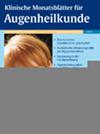Intravitreal Injections: Improving Sustainability by Reducing Clinical Waste.
IF 0.8
4区 医学
Q4 OPHTHALMOLOGY
引用次数: 0
Abstract
BACKGROUND Intravitreal injections are one of the most commonly performed procedures in ophthalmology. It is estimated that over 1 million intravitreal injections are performed in Germany annually. The aim of this study was to quantify the waste and carbon footprint associated with single-use injection sets, and to establish a waste reduction strategy. MATERIAL AND METHODS The clinical waste and associated carbon footprint from standard disposable injection sets used by tertiary referral centres in Germany (n = 6) and the United Kingdom (n = 2) were assessed. The safety of performing intravitreal injections with a minimalistic material-sparing approach was evaluated. RESULTS The average weight of an injection set (and hence the waste generated from each injection) was 165 g. On average, each injection set comprised 145 g (88%) of plastic, 2.1 g (1.3%) of metal, 4.3 g (2.6%) of paper), and 12.9 g (7.8%) of gauze/swabs. For 1 million injections, this equates to 145.2 tonnes (t) of plastic, 2.1 t of metal, 4.3 t of paper, and 12.9 t of gauze/swabs. A material-sparing approach can reduce injection set-associated waste by 99% without necessarily compromising safety. CONCLUSION A resource-saving approach to intravitreal injections can minimise the generation of clinical waste and its associated carbon footprint, thereby supporting sustainability.玻璃体内注射:减少临床浪费,提高可持续性。
背景玻璃体内注射是眼科最常见的手术之一。据估计,德国每年进行的玻璃体内注射超过 100 万次。材料和方法评估了德国(6 个)和英国(2 个)三级转诊中心使用的标准一次性注射器产生的临床废物和相关碳足迹。结果注射器的平均重量(以及每次注射产生的废物)为 165 克。每套注射器平均由 145 克(88%)塑料、2.1 克(1.3%)金属、4.3 克(2.6%)纸张和 12.9 克(7.8%)纱布/棉签组成。100 万次注射相当于 145.2 吨塑料、2.1 吨金属、4.3 吨纸和 12.9 吨纱布/棉签。结论 玻璃体内注射的资源节约方法可最大限度地减少临床废物的产生及其相关的碳足迹,从而支持可持续发展。
本文章由计算机程序翻译,如有差异,请以英文原文为准。
求助全文
约1分钟内获得全文
求助全文
来源期刊
CiteScore
1.30
自引率
0.00%
发文量
235
审稿时长
4-8 weeks
期刊介绍:
-Konzentriertes Fachwissen aus Klinik und Praxis:
Die entscheidenden Ergebnisse der internationalen Forschung - für Sie auf den Punkt gebracht und kritisch kommentiert,
Übersichtsarbeiten zu den maßgeblichen Themen der täglichen Praxis,
Top informiert - breite klinische Berichterstattung.
-CME-Punkte sammeln mit dem Refresher:
Effiziente, CME-zertifizierte Fortbildung, mit dem Refresher,
3 CME-Punkte pro Ausgabe - bis zu 36 CME-Punkte im Jahr!.
-Aktuelle Rubriken mit echtem Nutzwert:
Kurzreferate zu den wichtigsten Artikeln internationaler Zeitschriften,
Schwerpunktthema in jedem Heft: Ausführliche Übersichtsarbeiten zu den wichtigsten Themen der Ophthalmologie – so behalten Sie das gesamte Fach im Blick!,
Originalien mit den neuesten Entwicklungen,
Übersichten zu den relevanten Themen.

 求助内容:
求助内容: 应助结果提醒方式:
应助结果提醒方式:


